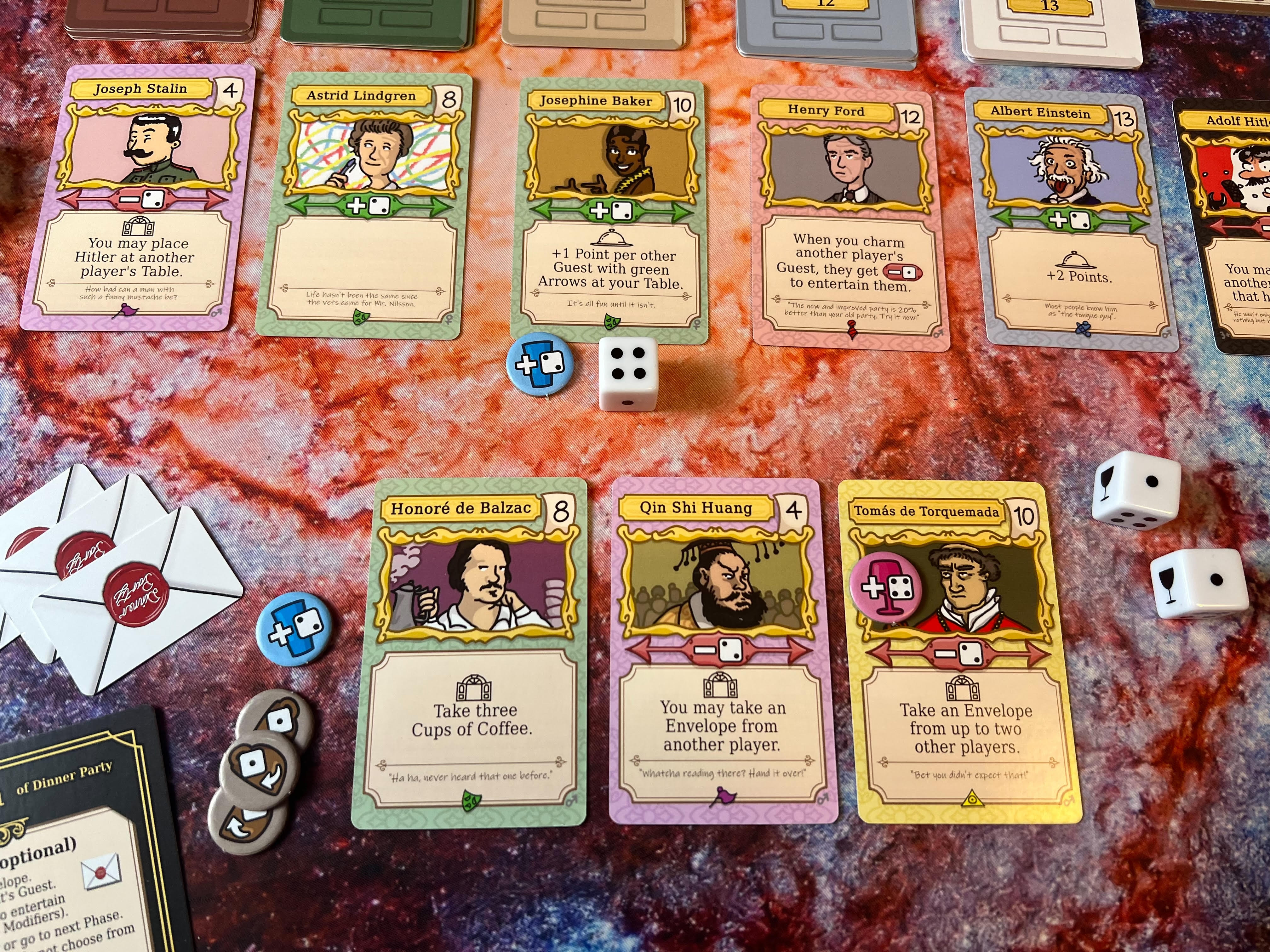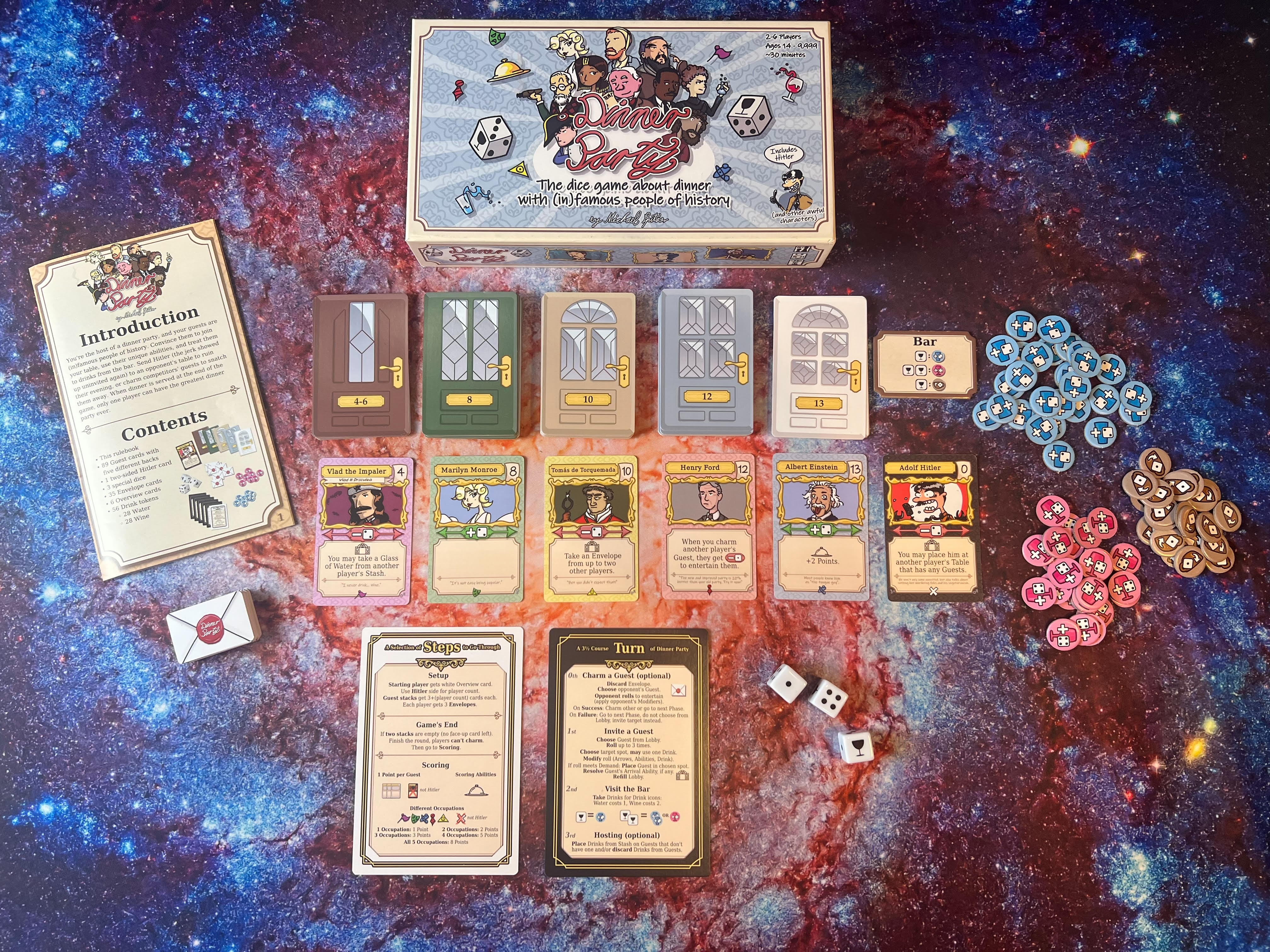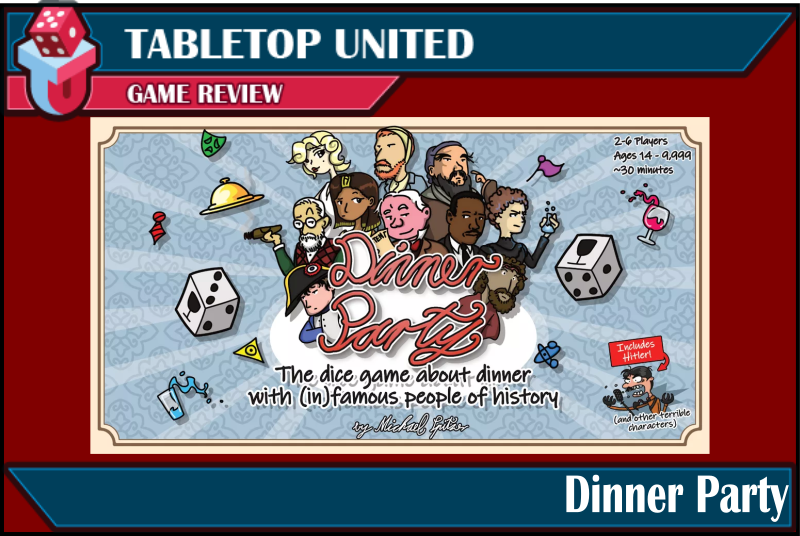Dinner Party
Designer: Micheal Spitzer
Artist: Michael Spitzer
Publisher: Failure Factory Games
Year Published/ Kickstarted: coming September 2024
No. of Players: 2-6 players
Ages: 14+
Playing Time: around 30 minutes
Main Mechanics/Theme: Dice Rolling, Re-rolling and Locking, Push Your Luck, Set Collection
The dice game about dinner with (in)famous people of history.
Roll dice to invite guests to your party. Offer them drinks to entice them to come to your party. Charm guests from another dinner party to come to your dinner table. When dinner is served, the player with the most points, determined by the most famous or infamous characters at their table, is the winner.
Disclaimer: Failure Factory provided the author an advance copy of this game for review.
The publisher provided additional content for the game beyond the materials included in the base game.
Overview:
You are the host of a dinner party, and your guests are famous and infamous people of history. Convince them to join your table, use their unique abilities, and offer them dinks from the bar. Send Hitler, the jerk that showed up uninvited, to another player’s table to ruin their party, or you can charm another player’s guest to steal them away to your table. At the end of the game, dinner is served at your party and only one player can have the most epic “Dinner Party” in history!

Here is a YouTube video for a quick overview of the game: https://www.youtube.com/watch?v=7KxwbydA7Hk
Gameplay and mechanics:
Setup involves the number of players in the game. There are lobby doors, sets of cards, to setup based on the number of players. Each lobby gets cards based on the number of players plus 3 cards. Lobby doors are in groups based on guests' demand value to enter a party. Hitler is placed next to the lobby. Each player gets 3 invite envelope cards to “Charm” other players’ guests at their dinner table. Drink tokens are placed next to the lobby to create a bar. The top card of each lobby deck is revealed below the deck. The first player is determined and game play begins.
The objective is to have the most guests and points at your dinner party when dinner is served. Guests can be invited or entertained using 3, 6-sided dice. The dice have 1 through 4 on them and 2 drink icons on the remaining sides.
Players take turns by naming a guest from the lobby to invite to their Dinner Party. They roll dice to see if they meet the demand of that particular guest. On each roll, of 3 total rolls, the player can bank dice to lock in a total for that roll. If the total, after 3 rolls, meets or exceeds the demand total of that guest, the player can seat that character at their dinner table.
During each player phase, you can (in order),
- Charm a Guest from another table- if you have an available invite envelope, you can “persuade” a guest from another player’s table to come to your party. The opposing player has to “entertain” that guest, by rolling their demand value, to keep them at their dinner table.
- Invite a guest from the lobby- players have 3 rolls to lock in a score to meet or
exceed the demand of an announced guest in the lobby. Players can determine which dice they would like to “lock in” before taking their second or third roll.
- Visit the bar- after trying to invite a guest and any drink icons remaining on your dice, you can convert to drinks for your stash from the bar.
- Hosting- you can place drinks on a character at your table to defend against other players from trying to “Charm” your guest to their party.
Dice modifiers come into play when you are seating a guest, to your Dinner Party, that has a +2 or -2 at your table. Certain guests have different modifiers. Some guests add 2 to your roll while other guests take 2 away from your roll because they were not necessarily nice people in history. Also, you can entice a guest, from the lobby, to come to your party by using a drink from the bar. A water drink adds a +2 to your dice roll and wine has a +4. A coffee can be used to get a 4th roll when trying for an invite.
If Hitler is placed at your table, he adds nothing to your total at the end of the game. He doesn’t have an occupation, but he does add -2 when you are trying to invite a guest to his end of the table during game play or when entertaining a neighboring guest. He makes it harder for you to invite guests to your Dinner Party or defend a challenge on his side of the dinner table.
If a player decides to use the “Charm a Guest” option,at the start of their turn, they place one of their envelopes on a guest card at another player’s table. That player will have to “entertain” that guest to keep them at their Dinner Party. The challenged player will have to roll 3 times to meet or exceed that guest’s demand value. Modifiers, such as, drinks placed on the guest or neighboring guest also come into play. If you cannot meet the demand value to entertain that guest, the card goes to the challenging player. If the guest couldn’t be charmed, the player resumes with the original player who started the challenge, and they get to try to invite a guest.
The game continues around the table until 2 guest stacks, in the Lobby, cannot be refilled. Invite envelopes can no longer be used to charm a guest. This triggers the end of the game. Play continues to finish the round, so all players have an equal amount of turns. Then, dinner is served and the game ends.
Scoring is relatively simple. Players get one point for each guest at their table except for Hitler. He counts for absolutely nothing. Each guest has an occupation listed at the bottom of their card. Extra points are awarded for each different type of occupation that you collected at your table. Some guest cards have a bonus when scoring. For example, William Shakespeare gives you +1 point for each envelope you have remaining in your stash while Audrey Hepburn gives you +1 point for each Art occupation you have at the table. A complete set of all 5 occupations; politics, art, science, economy and religion gives you 8 additional points when scoring.

Theme, Artwork and Illustration, Graphic Design and Layout:
The artwork for this game uses a humorous cartoon theme. This ties into some of the dark humor of this game really well. The artwork is very reminiscent of color comic strips that appeared in the Sunday edition of the newspaper which is something older players, like me, may appreciate. The background of each card uses pastel colors that are subtle and do not distract from the game of the feature artwork on each card. While the artwork for this game does provide toward the theme, the artwork was not my favorite characteristic of the game. The drink tokens are colorful and tie into the theme of the cards following the same style. The tokens are similar to other games with tokens that came on a punch card. The dice are large cubes with flush, black graphics and a gloss finish. The cards have a smooth finish and are of a sturdy, medium weight. The box art has the same cartoon characters on it which follows the theme of the game. I feel that the box art is something that lacks luster and can be improved. While it has a thematic,humorous design, the game title is small and the box colors are subtle and don’t really pop. It is something that can hinder a casual buyer browsing the shelves of a game store and might pass by this fun game.

Inclusivity and Accessibility:
Dinner Party has a diverse collection of characters from all creeds, races, geography, and all walks of life. Some people may be offended by characters, such as, Hitler, Stalin, Hirohito, Che Guevara, or Idi Amin (just to name a few). However, I have played this game several times with diverse groups of people of different ages (ranging from teenagers though people in their 50s) and none of them found any of these characters offensive. Rather, they found some of them humorous when inviting infamous people to a Dinner Party with other famous people. Let’s face it. Adolf Hitler was not a nice person. The Hitler card is basically the “Old Maid” card from the classic children’s card game. It is a card that you do not want in your collection and it can affect your game play or strategy.
Each guest has humorous lore, at the bottom of their card, that adds to the historic value of the game. Some of the people that I played this game with looked up biographies of some of these characters to learn about the guest or there was discussion about the character. The game does have a bit of educational value.
The game really doesn’t have too many physical limitations. You are not required to hold a hand of cards because all cards are laid out on a table. You do have to roll 3 dice at one time. Everything is within reach within each player’s spot. While certain guest cards have colored backgrounds that describe the character, they are accompanied by symbols that describe the character and abilities as well. Each occupation is a certain color, but again, each has its own symbol, so if a player was color blind, they should be able to enjoy this game without much difficulty. The fonts used on the cards are clear and legible while the text on the card is large and easy to read. I wear corrective lenses, and I had no problem reading any of the text where I struggle with some games. The lore text at the bottom of the card is a smaller font, but having to read it is not required for game play.
What worked:
Dinner Party setup is relatively quick and simple. After a few turns, it does start to have a larger footprint on the gametable after several guests were added at the player's dinner tables. On that note, an average sized table worked well with the game. It is easy to teach to new players. The game is fast paced, lighter and plays in about 30 minutes. As I previously mentioned, scoring is not complicated. Everyone I played with enjoyed the press your luck aspect of the game. Dinner Party has some educational value to it, but it does bring out some laughs while playing it. Players do have to use some strategy when determining which guest you are going to invite to your party. Having the ability to decide which dice you are going to keep each roll adds to the strategy of the game. Some characters have abilities when they arrive at your dinner table or can modify some of your rolls. This added a fun dimension when planning each turn. With that being said, planning your turn does not take up that much time and the game flows very well. The dice are unique with only using four sides for numbers and 2 sides for drinks. Incidentally, the highest roll you can get is a twelve, and some guests have a demand value of 13. Players have to use bonuses, modifiers and drinks at just the right time to invite guests with a higher demand value. The game has 89 different guests cards in five different decks where not all of the cards are used, adding to the replayability of Dinner Party.
Final thoughts:
The game is fun! Everytime it was brought to the table, we played it more than once. As I mentioned, it is fast paced and flows very well. This was positive feedback from everyone who has played it. It has a high replayability value with the different guests appearing in the lobby almost every game. Even if you are unsuccessful at inviting a guest, the dice rolls are still enjoyable and forgiving when they reward you with drinks from the bar on occasions. Many times, when we played, it looked like someone was losing, but ended up winning and vice-versa. This made us want to play another game immediately knowing victory was so close. Dinner Party has a certain uniqueness with the variety of historical characters that are brought into the game that opens a fun discussion as the game progresses, which to me, is one of the purposes of playing a board game with friends. The game works well with 2 players or six. I cannot say that it really shines with a certain player count. While you have to rely on luck of the dice rolls, you still have some dice mitigation by using drinks or some of the guest abilities who are seated at your dinner table.
When this game takes off, I can see the potential of Failure Factory Games offering expansion packs with additional cards for guests or different drinks and modifiers, such as the possibility of cocktails or hor d’oeuvres.
The instruction booklet was easy to read, clear and concise. It provided enough colorful illustrations to understand the instructions. However, there was a little confusion when trying to understand the Hitler card and its demand and uses when playing with 3 or more players. Hitler is the only card whose rules change when playing with more players other than 2. The section that discusses his card was not exactly clear. After reading the FAQ section on the back of the instruction booklet, and playing a game, the rule for Hitler was brought to light and understood which made the next game with more than 3 players much more enjoyable.
If you are a fan of press-your-luck dice games, set collection and a history buff, you will like Dinner Party. It is a lighter game with easy mechanics and quick setup that will be brought to our table many times in the future.

Check out DInner Party on Kickstarter: https://www.kickstarter.com/projects/failurefactorygames/dinner-party-dinner-with-infamous-people-of-history?ref=clipboard-prelaunch
For more information about Dinner Party, click on the link to direct you to Board Game Geek: https://boardgamegeek.com/boardgame/416537/dinner-party/credits
If you liked this review, please consider joining us on our social pages or subscribing to our newsletter.
FB Community: https://www.facebook.com/groups/ttucommunity/
Twitter: https://twitter.com/TabletopUnited
Instagram: https://www.instagram.com/tabletop_united/
Newsletter: https://www.subscribepage.com/tabletopunited


